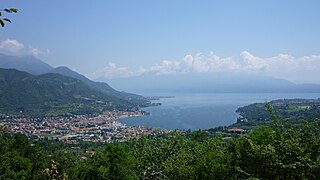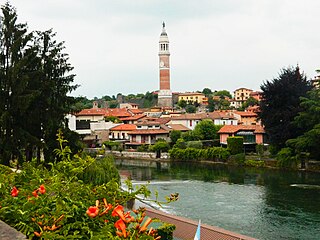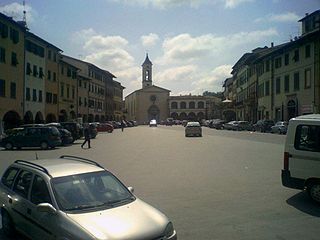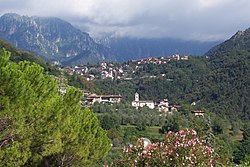
Lake Garda is the largest lake in Italy. It is a popular holiday location in northern Italy, about halfway between Brescia and Verona, and between Venice and Milan on the edge of the Dolomites. Glaciers formed this alpine region at the end of the last Ice Age. The lake and its shoreline are divided between the provinces of Verona, Brescia (south-west), and Trentino (north). The name Garda, which the lake has been seen referred to in documents dating to the eighth century, comes from the town of the same name. It is the evolution of the Germanic word warda, meaning "place of guard" or "place of observation."

Lake Como is a lake of glacial origin in Lombardy, Italy. It has an area of 146 square kilometres (56 sq mi), making it the third-largest lake in Italy, after Lake Garda and Lake Maggiore. At over 400 metres deep, it is one of the deepest lakes in Europe, and the bottom of the lake is more than 200 metres (660 ft) below sea level.

Salò is a town and comune in the Province of Brescia in the region of Lombardy on the banks of Lake Garda, on which it has the longest promenade. The city was the seat of government of the Italian Social Republic from 1943 to 1945, with the ISR often being referred to as the "Salò Republic".

Desenzano del Garda is a town and comune in the province of Brescia, in Lombardy, Italy, on the southwestern shore of Lake Garda. It borders the communes of Castiglione delle Stiviere, Lonato, Padenghe sul Garda and Sirmione.

Lonato del Garda is a town and comune in the province of Brescia, in Lombardy, northern Italy. Lonato is located about halfway between Milan and Venice, on the southwest shore of Lake Garda, the biggest lake in Italy.

Palazzolo sull'Oglio is a city and comune in the Province of Brescia, in the region of Lombardy in northern Italy. It is located south of Lake Iseo, bordering the Province of Bergamo, and has a population of 20,208. It is the fifth largest city in the Province, after Brescia, Desenzano del Garda, Montichiari and Lumezzane.

Sirmione is a comune in the province of Brescia, in Lombardy. It is bounded by the comunes of Desenzano del Garda (Lombardy) and Peschiera del Garda in the province of Verona and the region of Veneto. It has a historical centre which is located on the Sirmio peninsula that divides the lower part of Lake Garda.

Poggibonsi is a town in the province of Siena, Tuscany, central Italy. It is located on the Elsa River and is the main centre of the Valdelsa Valley.

Bagni di Lucca is a comune of Tuscany, Italy, in the Province of Lucca with a population of about 6,100.

Brenzone sul Garda is a comune (municipality) in the Province of Verona in the Italian region Veneto, located on the eastern shore of Lake Garda about 120 kilometres west of Venice and about 35 km (22 mi) northwest of Verona.

Castelnuovo del Garda is an Italian comune (municipality), in the Province of Verona, in Veneto, on a couple of morainic hills few kilometers south-east from Garda lake. Verona is about 15 km to the east, Venice is 120 km east and Milan 150 km west.

Malcesine is a comune (municipality) on the eastern shore of Lake Garda in the Province of Verona in the Italian region Veneto, located about 120 kilometres northwest of Venice and about 40 kilometres northwest of Verona.

Bogliasco is a comune (municipality) in the Metropolitan City of Genoa in the Italian region Liguria, located about 11 kilometres (7 mi) southeast of Genoa. Together with the comuni of Camogli, Recco, Pieve Ligure and Sori, it is part of the so-called Golfo Paradiso. Economy is mostly based on tourism; agriculture include production of olives.

Figline Valdarno is a frazione in the comune of Figline e Incisa Valdarno in the Metropolitan City of Florence in the Italian region of Tuscany, located about 25 kilometres (16 mi) southeast of Florence. It is the birthplace of Marsilio Ficino.

San Casciano in Val di Pesa is a comune (municipality) in the Metropolitan City of Florence in the Italian region Tuscany, located about 15 kilometres (9 mi) southwest of Florence.

Tavarnelle Val di Pesa is a comune (municipality) in the Metropolitan City of Florence in the Italian region Tuscany, located about 25 kilometres south of Florence.

Batignano is a small town in southern Tuscany, a frazione of the comune of Grosseto, positioned at about 10 km north-east of the capital on one of the last foot-hills of the valley of Ombrone which dominated the ancient city of Roselle.

Ledro is an Italian comune (municipality) in Trentino in northern Italy. It was created on January 1, 2010, by the union of the former comuni of Pieve di Ledro, Bezzecca, Concei, Molina di Ledro, Tiarno di Sopra and Tiarno di Sotto.

Cellena is a village in Tuscany, central Italy, administratively a frazione of the comune of Semproniano, province of Grosseto. At the time of the 2001 census its population amounted to 77.




























